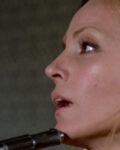CD: Runaway Train (1985)
 Rating: Excellent
Rating: Excellent
Label: La-La Land
Released: August 10, 2009
Tracks & Album Length: 18 tracks / (77:41)
Composer: Trevor Jones
Special Notes: 12-page colour booklet with liner notes by Brian Satterwhite. Limited to 3000 copies.
Review:
For some soundtrack fans, it was a bit of surprise to learn the composer of pioneering synth scores had begun his career with large orchestral scores for John Boorman’s Excalibur (1981) and Jim Henson’s The Dark Crystal (1982).
The reason this was significant is because Trevor Jones’ film career reached its broadest popularity via a series of suspense and psychological thrillers, notably Angel Heart (1987), Sea of Love (1989), and Bad Influence (1990), as well as Kiss of Death (1995), In the Name of the Father (1993), and to some extent the WWII upgrade of Shakespeare’s Richard III (1995).
The most overt signs of Jones’ synth-rock style was bass drones, neo-music concrete samples, and a generally sense of dread that rarely let up – the exceptions being a classical piece, or a jazz theme variation (Bad Influence’s slow jazz version being the best example of Jones’ astute arranging skills).
The composer has scored a considerable variety of films since the mid-nineties, but his early synth scores remain particularly notable because with rare exceptions, they weren’t repetitive or derivative of anyone else’s work. Jones would repeat aspects in later suspense scores, and if they seemed thematically repetitive, it was often due to the more impressionable albums which rarely gave the full score much time on LP.
His synth period occurred during the waning years of vinyl, and the projects were often films aimed at broad markets, so that pretty much meant the commercially released albums either featured one or two score cuts with a heavy song quotient, or the albums repeated whole cues – as was the case with already absurdly brief Sea of Love.
(There were also the ‘filmic journeys’, albums heavily remixed with sound effects and dialogue, for the two Alan Parker films the composer scored – Angel Heart, and Mississippi Burning. Both are outstanding scores mucked up by a high concept remix that ruins all attempts to enjoy and revel in the composer’s style.)
Runaway Train (1985) was the bridge between the era’s overt pop rock style and Jones’ signature drone style, as well as being a rare score that receieved a virtually complete representation on LP. Its kinetic nature, not to mention the iconic synths used to create the beats and pulses, either delighted the composer’s fans, or had them giving the original LP less play time because it was more rock-styled than the chilling mood pieces that quickly followed.
What’s important about Train are the concepts the composer was already exploring – orchestral emulations, wooden percussion emulations, as well as a diverse series of rhythms – and some early traces of that patented moody tone he’d iron out to its most haunting incarnation in Angel Heart (as in the cue “Reflections”).
La-La Land’s CD offers two score interpretations: the LP, as well as the original film mixes. Most interestingly, because the score cuts were fairly brief, material was expanded for the LP, and the albums sound bears more breadth than the surviving score masters (unless it’s an after-effect from the original analogue album mastering).
The CD includes a source cue (“The Yellow Rose of Texas”) as well as an alternate version of the orchestral Vivaldi piece “Gloria in D Major – Et in Terra Pax, but the real draw for fans is the fact La-La Land have made a point in sticking to the deliciously fat analogue sound. It’s a flawless transfer that’s even better than the LP – the original stock wasn’t great, and some electronic subtleties weren’t as prominent – and whether the CD is piped through a contemporary or vintage amplifier, Jones’ score really shines.
Most of the cues run between two and four minutes, so there’s a lot of meat to the cues, and while some cuts are purely rhythmic indulgences, the emulations are punchy and groovily aggressive. A major highpoint is “Clear the Tracks,” which includes emulations of Asian percussion, and is probably from the same bank of samples used by John Carpenter and Alan Howarth in Big Trouble in Little China (1986). Some of the keyboard tones, guitar and electric bass emulations are also nearly identical to sounds more heavily used by Tangerine Dream in scores like Near Dark (1987).
Jones thickens his textures, pinches the guitar emulations without delving too much into the Wailing Guitar Syndrome of the era, and maintains busy keyboard figures throughout the score – combinations that keep the tension high after some rare introspective cues.
Just as surprising is the naturalness in shifting from synths to the gorgeous Vivaldi chorale that closes the film, and part of that ease stems from Jones’ maintaining a mournful, desperate tone, as well as a few brief melodic fragments. Perhaps the most cohesive element is the synth fanfare (“Runaway Train,” and particularly “Collision Course”) with brass, strings, dual electric guitar, electric bass, which gives the film a kinetic orchestral motif relative to the formal orchestral sound of the classical piece. Jones also adds a female voice in the brief “Past, Present – Future?” which sort of prepares audiences for the full vocal beauty of the final cue.
Runaway Train is one of the rare eighties synth scores that’s aged well – extremely well – because the sounds are pure, warm in the analogue density, and more contemporary composers (Tyler Bates, in particular) have mine these vintage sounds in ways that pay homage to the predecessors and support a film’s drama.
La-La Land’s CD also comes with solid liner notes on the film and music, as well as concise cue breakdowns.
© 2009 Mark R. Hasan
External References:
IMDB — Soundtrack Album — Composer Filmography — Film Review
Category: Soundtrack Reviews

















Connect